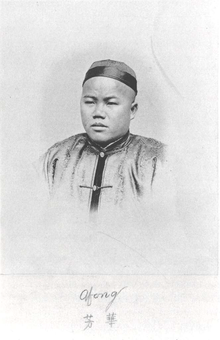Lai Afong
Lai Afong | |
|---|---|
 Only known self-portrait and autograph of Lai Afong. c.1870 | |
| Born | 1838 or 1839[1] |
| Died | (aged 51)[1] |
| Other names |
|
Lai Afong (Chinese: 赖阿芳) (c.1839 - 1890) was a Chinese photographer who established Afong Studio, one of the early photographic studios in Hong Kong.[1] He is considered to be the most significant Chinese photographer of the nineteenth century.[2]
Work
His studio was active from 1859 to around the 1940s. The business was probably taken over by his son in the 1890s.[3] Subject matters ranged from portraits and social life pictures to cityscapes and landscapes. Lai's work and person were praised by John Thomson, a Scottish photographer working in China at the time, in Thomson's book The Straits of Malacca, Indo-China, and China.[4] Lai's experience totally originated into the Western community, but it still reveals the same sensibility of the literati painting which embodied both learned references to the styles of ancient masters and the inner spirit of the artist.[5] According to the verso of many of his Carte de visite works, he was photographer to Sir Arthur Kennedy KCB and Grand Duke Alexis.
Retracing our steps to Queen's Road, we pause before a display of huge signboards, each one glowing in bold Roman letters with the style and title of some Chinese artist. The first we come to is that of Afong, photographer: to this succeeds Chin-Sing, portrait painter. Then follows Ating; and many others make up the list of the painters and photographers of Hongkong. Afong keeps a Portuguese assistant to wait upon Europeans. He himself is a little, plump, good-natured son of Han, a man of cultivated taste, an imbued with a wonderful appreciation of art. Judging from his portfolios of photographs, he must be an ardent admirer of the beautiful in nature; for some of his pictures, besides being extremely well executed, are remarkable for their artistic choice of position. In this respect he offers the only exception to all the native photographers I have come across during my travels in China. He shows not a single specimen of work at his doorway, whereas his neighbour Ating displays a glass case containing a score of the most hideous caricatures of the human face that it is possible for the camera obscura to produce.
—John Thomson, The Straits of Malacca, Indo-China, and China, 1875
Gallery
-
Panorama of Gulangyu Island and Amoy
-
A commercial street in Guangzhou
-
studio portrait
See also
References
- ^ a b c d Bennett, Terry (2013). History of Photography in China: Chinese Photographers 1844-1879. London: Bernard Quaritch. ISBN 9780956301246. Archived from the original on 28 June 2017. Retrieved 28 June 2017.
{{cite book}}: Unknown parameter|deadurl=ignored (|url-status=suggested) (help) - ^ Hannavy, John (2013). Encyclopedia of Nineteenth-Century Photography. Routledge. p. 815. ISBN 9781135873264. Retrieved 10 September 2015.
- ^ "Afong" on Wattis Fine Art website
- ^ Thompson, John (1875). The Straits of Malacca, Indo-China, and China. Harper & brothers. pp. 188–189. Retrieved 11 November 2015.
- ^ Meccarelli M. "New Perspectives about the Origins of Chinese Photography and Western Research in China" in ARTE DAL MEDITERRANEO AL MAR DELLA CINA Genesi ed incontri di scuole e stili. Scritti in onore di Paola Mortari Vergara Caffarelli eds. P. Fedi-M. Paolillo, Officina di Studi Medievali , Palermo, 2015, pp. 587-598
Further reading
- Bennett, Terry (2009). History of Photography in China 1842-1860. Bernard Quaritch. ISBN 978-0-9563012-0-8.
- Bennett, Terry (2013). History of Photography in China: Chinese Photographers 1844-1879. London: Bernard Quaritch. ISBN 9780956301246. Archived from the original on 28 June 2017. Retrieved 28 June 2017.
{{cite book}}: Unknown parameter|deadurl=ignored (|url-status=suggested) (help) - Chen, Shi (2009). Early Chinese Photographers from 1840 to 1870: Innovation and Adaptation in the Development of Chinese Photography (PDF) (Master of Arts thesis). University of Florida. Retrieved 26 February 2015.
- Cody, Jeffery W.; Terpak, Frances, eds. (2011). Brush & Shutter : early photography in China. Los Angeles, California: Getty Research Institute. ISBN 978-1-60606-054-4.








